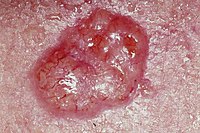
Photo from wikipedia
Background The risk for keratinocyte cancer is dramatically increased in solid organ transplant recipients (OTR) with a first post-transplant keratinocyte cancer conferring a high risk for subsequent keratinocyte cancer arising… Click to show full abstract
Background The risk for keratinocyte cancer is dramatically increased in solid organ transplant recipients (OTR) with a first post-transplant keratinocyte cancer conferring a high risk for subsequent keratinocyte cancer arising with accelerated dynamics. Despite cumulative ultraviolet radiation (UVR) being the primary responsible environmental carcinogen reduced compliance with photoprotective measures among OTR has been reported. Risk assessment tools could help guide clinical decision-making and targeted prevention strategies for patients at particularly high risk for post-transplant keratinocyte cancer. Objectives To evaluate cumulative sun exposure by means of an assigned total sun burden (TSB) score, sunscreen use and associated risk factors for keratinocyte cancer in the post-transplantation phase of OTR. Methods A retrospective single-center cohort study analyzing medical records and standardized questionnaires of 290 OTR cared for at a German dermatology transplant clinic. Results Significantly lower TSB scores were noted in OTR not developing a first keratinocyte cancer compared to OTR developing keratinocyte cancer during their follow-up period (P = 0.005). Regression analysis assigned a significantly higher risk for the development of first keratinocyte cancer to OTR with TSB scores >10. In total 70.7% of OTR with a history of ≥1 keratinocyte cancer reported intermittent sunscreen use, while daily sunscreen use was overall associated with female gender (21.3%) and age >30 years (17.6%). Conclusions The risk of OTR for developing keratinocyte cancer is reflected by their UV-exposure patterns, which may be assessed by the TSB-score, a scored risk assessment tool. Complementing clinical data, the TSB score may help clinicians to identify OTR at particularly high risk for keratinocyte cancer and to endorse intensified prevention strategies and dermato-oncologic care.
Journal Title: European Journal of Cancer Prevention
Year Published: 2022
Link to full text (if available)
Share on Social Media: Sign Up to like & get
recommendations!